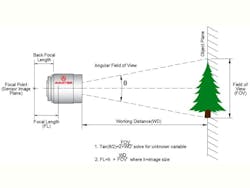Mastering Imaging Essentials
Mastering Imaging Essentials: A Guide to Field of View, Resolution, and More
Understanding the fundamental concepts of imaging is essential for anyone involved in photography, microscopy, or any field that relies on optical instruments. These terms serve as the building blocks upon which more complex ideas are constructed. Field of view (FOV), working distance (WD), resolution, depth of field (DOF), sensor size (H), pixel size (s), and magnification (m) are pivotal in comprehending the capabilities and limitations of imaging systems. Whether it’s capturing a breathtaking landscape, delving into microscopic worlds, or enhancing scientific research, grasping these concepts empowers users to optimize their equipment and achieve their desired results.
The following terms explain the most basic concepts of imaging and will be referenced throughout the remainder of this guide.
- Field of View (FOV): The field of view refers to the extent of the observable world that is visible at any given moment through a particular device or optical instrument, such as a camera, microscope, or binoculars. It is typically expressed in degrees and represents the angular extent of the scene that can be captured or observed. (Reference: Understanding Field of View (FOV) and Angular Field of View (AFOV) in Camera Lenses)
- Working Distance (WD): The working distance refers to the distance between the front optical surface of a lens or other optical device and the object or surface being observed or imaged. In simpler terms, it is the distance from the lens to the object being focused on.
- Resolution: The minimum feature size of an object that can be distinguished by an imaging system is typically specified as spatial frequency, often measured in units of line pairs per millimeter.
Spatial frequency refers to the number of pairs of alternating light and dark lines that can be distinguished within a millimeter of the image. This measurement indicates the system’s ability to resolve fine details or patterns. In optical systems, such as cameras or microscopes, resolution is closely related to spatial frequency. Higher spatial frequencies correspond to finer details that the system can resolve. Therefore, a higher spatial frequency corresponds to a higher resolution and has the ability to distinguish smaller features in the captured image.
- Depth of Field (DOF): The depth of field refers to the range of distance in a scene, from the nearest to the farthest objects, that appear acceptably sharp in an image. In photography and imaging, it describes the area within which objects are in focus, both in front of and behind the focused subject. DOF is influenced by factors such as aperture size, focal length, shooting distance, and sensor size. Generally, a larger aperture (smaller f-number) results in a shallower depth of field, while a smaller aperture (larger f-number) increases depth of field, keeping more of the scene in focus.
- Sensor Size (H): The sensor size is the size of a camera sensor’s active area, typically specified in the horizontal or vertical dimension. This parameter is important in determining the proper lens magnification required to obtain the desired FOV. The sensor size, particularly its horizontal dimension, plays a significant role in photography and in imaging systems. A larger sensor size generally allows for capturing more light and detail, resulting in higher image quality and better low-light performance.
- When selecting a lens for a camera system, knowing the horizontal dimension of the sensor is essential for calculating the appropriate focal length needed to achieve the desired FOV. The relationship between sensor size, focal length, and FOV is crucial for achieving the desired composition and framing in photography or videography.
- Pixel Size (s): Typically square in shape, pixels make up the sensor grid and have a dimension in the order of micrometers or microns [μm].The size of pixels on a sensor plays a crucial role in determining various aspects of image quality, including resolution, sensitivity, and dynamic range. Larger pixels can capture more light and are generally associated with better low-light performance and higher dynamic range. On the other hand, smaller pixels can provide higher resolution but may suffer from increased noise and reduced light sensitivity.
- Magnification (m): The magnification of a lens, sometimes referred to as PMAG (Primary Magnification), is defined as the ratio between the sensor size and the FOV.
In conclusion, the foundational concepts described in this article lay the groundwork for a deeper understanding of imaging technology. From the expansive field of view that frames our visual perception to the intricate pixel size that determines image resolution, each term plays a crucial role in shaping the final image or observation. Mastery of these concepts enables photographers, scientists, and enthusiasts alike to make informed decisions when selecting equipment, manipulating settings, or interpreting results. As imaging technologies continue to advance, a solid comprehension of these fundamentals will remain invaluable, guiding practitioners toward ever greater feats of visual exploration and expression.




